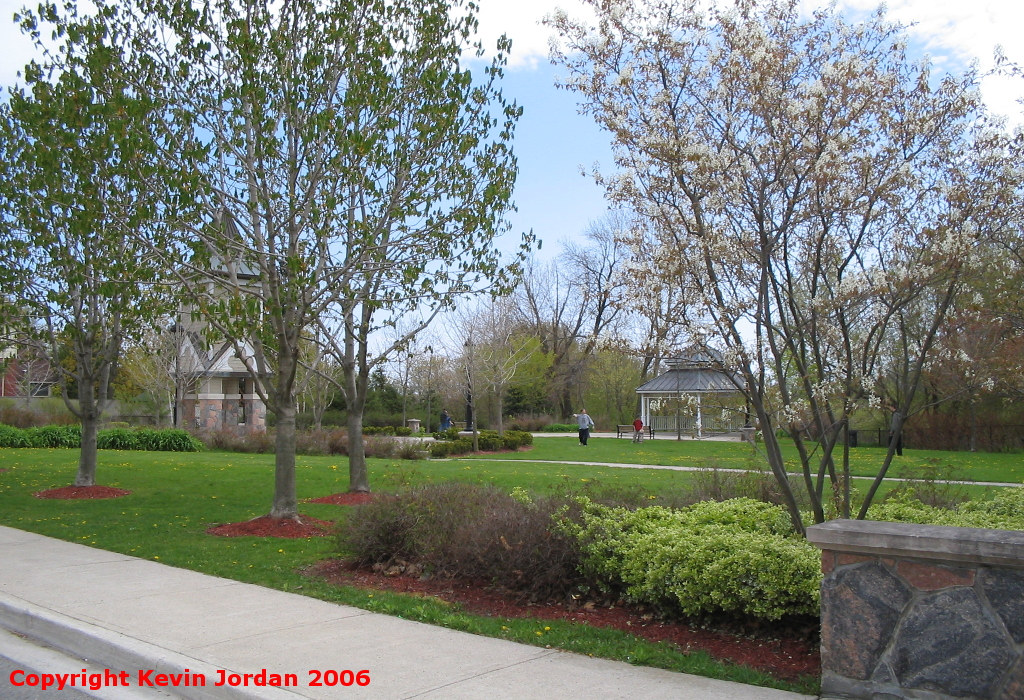
Oshawa Generals
Arena Name: Bowmanville Memorial Arena
Capacity: 970
Built: 1948
Last OHA Game: 1964
Torn Down: 1988
Address: 192 Queen St, Bowmanville, ON, L1C 1M7
Ice Surface Size: 175' X 75'

Bowmanville Memorial Arena Site

What Was the Arena Like?
Bowmanville Memorial Arena was used briefly by the re-born Oshawa Generals in the early 1960's while the Oshawa Civic Auditorium was under construction. Judging by the stats provided by the Municipality of Clarington, the arena appears to have been tiny in the extreme in both capacity and ice surface. I have no information other than that which was provided by the town; if you have anything to contribute please email me at
 .
.Mike Cherkas remembers:
The arena was tiny. You mention that the official capacity was 970. That sounds like a figure from more recent years when fire regulations have become more stringent. When the Generals played there, attendance figures were usually given in the 1200-1500 range. I do remember that the few times I went games there (as a kid) the standing room was always packed (usually three deep). And at either end, more than a few brave souls climbed the rafters to get a better view of the action. There were three rows of heavily worn, dark blue wooden benches around the sides and ends of the rink. I can't remember if the these benches had a low back on them or not. At each end there was a wire mesh to protect fans from flying pucks. There was no glass or mesh along the sides, so you could lean over the boards to follow the action on the near side as it progressed towards either end into the corners. Fans had to pay attention. Oh, and it was bloody cold in there.
The following information was provided by the Municipality of Clarington, whom I thank.
The Bowmanville Memorial Arena was situated on Queen Street, just below the end of Temperance Street, overlooking the Bowmanville Creek Valley. The arena property involved 4.47 acres and had a frontage of 280.5' on an irregular shaped lot. The parking lot on the south side of the arena could accommodate about 20 to 25 cars. The seating capacity of the arena was 640, with 330 standing room for a total of 970 people. These figures were determined by the Newcastle Fire Department. The overall outside dimensions of the main arena building were 196' x 106' and the ice surface approximately 175' x 75'. An 80' x 24' two-storey front building section was located on the north side of the arena and 27' x 66' extension on the west end of the arena housed the ice plant and the surfacing machine.
The arena was constructed in 1948, at which time the bowstring trusses were supported by concrete block load bearing walls and pilasters. In 1959, structural steel columns supported on piles were introduced to relieve the severely cracked perimeter walls of the truss loads. When the arena opened its doors for business in 1949, it relied on natural ice. The Kinsman Club of Bowmanville assumed the financial responsibility for having artificial ice installed in the Bowmanville Memorial Arena in 1952. In 1960, the refrigeration plant and ice surface equipment building, west of the main arena area was built after the existing boiler room collapsed. In 1971, the existing bowstring trusses were repaired. A new plastic brine "U" pipe system was installed in 1976. However, the arena floor was sand and as such was not usable in the spring or summer.
A visual and dimensional inspection of the Bowmanville Memorial Arena was carried out in August 1976, at which time the timber trusses, roof purlines and miscellaneous framing members of the arena structure were examined. Later in 1976, Totten Sims Hubicki & Associates carried out an inspection and recommended further work to the roof structures at a cost of $45,000. This work was completed in February of 1977. In 1982 another inspection was carried out by Totten Sims Hubicki & Associates and minor repairs were made to the roof structures. In May of 1983, several more cracks in the roof trusses were discovered.
Each year, more and more repairs were needed to keep the facility operational. At the same time, more inspections were required to ensure the safety of the various user groups. Given these circumstances, it was appropriate that the Corporation of the Town of Newcastle examine the future of the Bowmanville Arena by way of a feasibility study.
A feasibility study was conducted from September 1984 to May 1985 to examine the best course of action with respect to the Bowmanville Arena. And, if the arena was to be replaced, make recommendations as to where it should be located, what features should be incorporated and how to accomplish a new facility in a financially feasible way. Community needs were assessed, along with future population trends. There was a geotechnical investigation conducted in July 1988 were it is noted that the property was to be sold and the existing building be demolished due to the on-going problems with the structure of the building, so demolition was sometime after that.
The Garnet B. Rickard Recreation Complex opened in 1988.
What's the Arena Used for Today?
After the famous fire which levelled Hambly Arena in the autumn of 1953, the Generals were left homeless and disbanded. The residents of Oshawa never forgot the team though, and throughout the 1950's there was a concerted community effort to "bring back the Gens" to Canada's Motor City. In the fall of 1962, the Toronto Maple Leafs were looking for GTA-area teams to help sustain and fill out their fledgling Metro Junior League, and Wren Blair helped lead an effort both to help rebuild the Generals franchise and get a new arena under construction in Oshawa. The new Generals played at the Bowmanville Memorial Arena for their only season in the Metro League, and when the Metro experiment collapsed, they acquired the sponsorship of the Boston Bruins and rejoined the OHA. They played the 1963-64 season and the first part of the 1964-65 season in Bowmanville, and finally moved into the new Civic Auditorium on December 11, 1964.
Bowmanville Arena was demolished in 1988, and a pleasant city park was constructed on the site.
Bowmanville Arena was demolished in 1988, and a pleasant city park was constructed on the site.
Feedback
If anything is incorrect or you have something to add, please e-mail me at  and I'll update the guide.
and I'll update the guide.
 and I'll update the guide.
and I'll update the guide.Copyright © OHL Arena Guide, 2002-19.
All rights reserved.
Last Revised: December 8, 2019